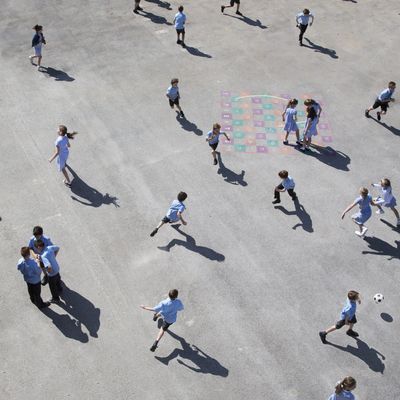
When children enter Helana Pennywell’s day care, she scans each small forehead with a thermometer. If they’re free of fever, they’re welcomed inside, where she sanitizes their belongings and makes sure they wash their faces and hands. She’s lucky: Her day care, which she runs out of her California home, is full. “I’ve noticed an increase in demand from essential workers who need care for their children,” she told Intelligencer.
But many child-care providers are less fortunate. The pandemic struck them with particular force, as lockdown measures have kept many working parents at home and limited gathering in groups. As HuffPost reported last month, data points to a potential catastrophe. Centers are closing, workers are losing their jobs, and parents are adrift. Experts say that without swift federal intervention, the child-care sector may never fully recover, and neither would the people who depend on it for their livelihoods.
Pennywell owes her stability in part to the Service Employees International Union, or SEIU. A member of SEIU’s California-based Local 521, she participates in the Carina directory, which connects union members who need child care with union members who provide it. Without that service, she said, “it probably would have been a little bit more difficult for me to stay open.” Even with Carina at her disposal, Pennywell’s worries aren’t completely over. The extra precautions she has to take to protect herself and the children in her care are also an extra expense; she says she’s going through cleaning supplies even more quickly than usual.
Increased expenses, combined with a sudden and drastic decrease in attendance and a general economic downturn, are putting other child-care providers out of work. “Child care and family child-care homes have been in a free fall since the stay-at-home orders, because they’re primarily driven by supply and demand,” explained Rhian Evans Allvin, who is the CEO of the National Association for the Education of Young Children, or NAEYC. “We don’t have exact numbers. But there are 2 million early-childhood educators in the workforce, and anywhere from 30 to 50 percent on furlough or unemployment.”
Thirty percent of child-care centers surveyed by NAEYC in March said they wouldn’t survive a closure of two weeks without some form of public aid. Another 49 percent said they lost income because families can no longer pay for their slots. Meanwhile, the Bipartisan Policy Center found in April that around 60 percent of the nation’s child-care programs had closed. Providers like Pennywell, who work out of their homes, are most likely to be open. But child-care centers are suffering, and so are the workers they employ. Only 10 percent of large centers surveyed said they’re open as usual; among smaller centers, the figure increases slightly to 16 percent. Analysis from the Center for American Progress, based on NAEYC’s survey data and CAP’s internal research on child-care deserts, estimates that as many as 4.5 million child-care slots could disappear if the federal government doesn’t intervene. One estimate from the National Women’s Law Center suggests that child-care centers need about $9.6 billion a month to stay open.
But to date, federal lawmakers have been slow to provide the sort of help that child-care workers and parents need. “In the CARES Act, there was funding for child care. It was about $3.5 billion. We believe that will be completely spent by states by the end of June,” Allvin said. The HEROES Act would allocate another $7 billion for child-care providers. The Child Care Is Essential Act, introduced by Democrats Rosa DeLauro and Bobby Scott in the House and by Patty Murray in the Senate, would establish a $50 billion stabilization fund within the Child Care and Development Block Grant program. Both bills would keep providers afloat for a while longer, though the HEROES Act has stalled in the Senate, and DeLauro’s legislation has a slim chance of becoming law.
In the interim, parents and child-care workers are struggling. Their plight highlights an unsettling outcome of pandemic life. The economic crisis the virus has generated dealt a significant blow to women. Just over half of all essential workers are women, the New York Times reported in April. Many still need child care, and they can’t always find it. Women are also more likely to have lost jobs as a result of the pandemic, and if child-care centers can’t reopen, the way back to the workforce might be difficult. Even women who’ve kept their jobs may eventually have to decide whether to keep working, or stay home as child-care slots disappear.
For women, the pandemic is a whetting stone. It sharpens the fault lines of an unequal world. Well before the pandemic, inequality divided on gendered and racial lines. American women are more likely than men to work low-income jobs; on average, women of color take home the lowest wages of all. They’re more likely to say they struggle to pay their medical bills, more likely to go hungry, and more likely to live in poverty overall. Because they are overrepresented in care work, like teaching and nursing, and in low-wage, precarious work like retail and food service, they were poorly positioned to withstand a pandemic. Add to that the burden of housework and caregiving, which still mostly falls on women, and the possibility that the pandemic could push many out of the workforce looks like a real threat.
“We’re already seeing the results,” said Julie Kashen, a senior fellow at the Century Foundation. “Now that we have child care and schools closed, women are already doing more of the caregiving.” Seventy percent of women surveyed by the New York Times and Morning Consult in early May said they were doing most of the housework during lockdown; 66 percent said they were also mostly responsible for child care. They seem to be doing the bulk of the homeschooling, too. Though almost half of all men with children under 12 said they did most of the homeschooling, only 3 percent of women agreed. Eighty percent of women said they took on most educational responsibilities at home.
As lockdown measures ease, child-care providers may struggle to reopen, and women who can afford it will look elsewhere for care. Without intervention from policy-makers, the pandemic could transform child care for the long term. Work could shift from centers, or from family day cares like Pennywell’s, to care provided in the home by nannies — who often lack important labor and workplace protections.
Though most domestic workers, including nannies, are entitled to minimum wage and overtime protections, Kashen, who also works with the National Domestic Workers Alliance, says that they’re excluded from many other labor laws. That includes the right to form a union. “Because they are often in one-on-one work situations, they are also often excluded from Title VII civil rights protections because there’s a 15 or more employee threshold,” she added. Many are immigrants, and like child-care workers in general, they tend to be badly paid. Allvin, of NAEYC, says the average child-care worker earns $10.70 an hour nationwide. Average pay for nannies can be more difficult to track. But for nannies in New York City, the Economic Policy Institute says the hourly rate is about $11.57 on average, well below a living wage for the area.
Angela, a nanny and an activist with NDWA, told Intelligencer that she suffered wage theft for years. (Because Angela is undocumented, Intelligencer is withholding her last name for her protection.) For eight years, she worked from 7 a.m. to 7 p.m. caring for the children of a New York City family. “I was just supposed to be doing babysitting, but ended up doing so much more. I was ironing, cleaning, taking out the trash, and was only getting paid $250 a week,” she said through a translator.
She works for “a really great family” now, she added. They gave her four weeks off, paid, when the pandemic began. Now that she’s back at work, they send a car to pick her up and drop her off. But her experiences demonstrate how sharply a nanny’s conditions can vary, based on the decisions of the family who hires her. If the child-care industry tilts toward in-home care, it will likely plunge workers even more deeply into precarity.
The SEIU program that helped keep Pennywell’s day care afloat is difficult to apply outside the context of organized labor. But there are other long-term solutions, advocates say, beyond an immediate influx of cash to providers. Angela wants federal lawmakers to pass the Domestic Workers Bill of Rights. Created by NDWA, and introduced by Representative Pramila Jayapal and Senator Kamala Harris in the House and the Senate, respectively, the bill would give nannies and other domestic workers paid sick days, guaranteed overtime pay, and create a Domestic Worker Wage and Standards board to universalize fair conditions.
Universal child care, as proposed by several former Democratic candidates for president, including Senators Bernie Sanders, Elizabeth Warren, and Kirsten Gillibrand, may also help workers and parents survive the next national disaster. “I think what I’m hearing right now is two parts of the conversation,” Kashen said. “There’s the immediate relief, and the longer-term rebuilding. The immediate relief is about making sure that many small businesses will be able to come back once we’re able to end the shelter in place in a safe way.”
The second piece, she added, is universal child care. “That needs to address a number of different things,” she said. “It has to make sure that child care is affordable for parents and available to them. It has to invest in the child-care workforce. The people who care for our children are paid about $11 an hour, which is a significant undervaluing of that work. It has racist and sexist roots, because caregivers were often enslaved black women. It became something that people didn’t think needed to be paid for. And we need to reverse that long history of discrimination, and start valuing care.”






























